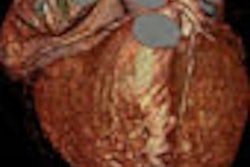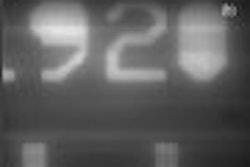There are clinical guidelines for determining which trauma patients should undergo CT of the neck, but there is little definitive advice on which patients should undergo CT angiography (CTA) to screen for blunt cerebrovascular injury (BCVI).
Studies suggest that contrast-enhanced CTA may be a nearly ideal modality for excluding vessel damage that could lead to stroke in the days and weeks following the injury. For this purpose, clinical experience suggests that CTA can generally outperform MR angiography.
In a talk at the 2007 Symposium on Multidetector-Row CT in San Francisco, Dr. Michael Lev, director of emergency neuroradiology at Massachusetts General Hospital in Boston, discussed the use of extracranial vascular imaging, particularly CTA, in blunt trauma patients admitted to the emergency department. Fully 60% of blunt cervical vascular injuries are unsuspected at admission, according to Lev.
"The presentation is often asymptomatic; the idea is to treat before they get a stroke," he said. "Headache is common, and the treatment is usually anticoagulation (heparinization), but sometimes that's not possible because the patient has injury in other places you can't anticoagulate. So there may not be a good way to treat them if there's truly extravasation or high risk; you may have to take the vessel down."
What are the most common diagnoses? Lev and his colleagues looked at two years of data from his institution consisting of 412 blunt trauma patients presenting with cervical spine fracture (the risk of vascular injury is certainly not limited to this group, he noted).
Of the 412 admissions, 100 patients underwent a vascular exam, demonstrating vertebral artery injuries in 20 patients, or 20% of the total. Most consisted of lateral mass articular processes (n = 17) or foramen transversarium fractures (n = 12), along with a smattering of dens fractures (n = 2), extension teardrop fractures (n = 2), or occipital fractures (n = 1). And most were occluded vessels, though others were simply narrowed, he said.
"There was only a single case, and it was bilateral, that actually involved the carotid (artery)," Lev said. "So at least in direct trauma associated with fractures, we're talking about vertebral artery injuries predominantly and not blunt carotid trauma. And small pseudoaneurysms can certainly be associated with vertebral injury."
There is a grading system for categorizing such injuries (Biffl et al) that ranges from grade I (< 15% narrowing) to grade IV (occlusion) and grade V (transection and extravasation), Lev said. The problem is that there's more to it than luminal narrowing -- sometimes there can be intimal flaps and other injuries even at grade I, he said.
At this point there's not a lot of guidance in the literature, according to Lev. But even in early studies of BCVI comparing CTA, MRA, and other modalities, CTA and MRA results often made a strong case for vascular screening in the setting of blunt cervical trauma, although the studies weren't always well executed.
Compared to cerebral catheter angiography, for example, Miller et al found vertebral artery injury sensitivities of 53% and 47% for CTA and MRA, respectively. Yet despite the low sensitivity of the tests, the stroke rate dropped markedly from 14% to 0% compared to a previous group that suggested that these modalities detected the vascular injuries presenting the greatest risk, Lev said (Annals of Surgery, September 2002, Vol. 236:3, pp. 386-393).
In the early studies, CTA was often performed by nonradiologists using CT slice thicknesses as high as 10 mm. But the results suggested a benefit from vascular screening nonetheless.
MRA has other issues compared to CT, Lev said, including comparatively larger pixels than CTA (256 x 256 matrix compared to 512 x 512 in CTA), sensitivity to patient motion, lack of availability in some facilities, significant patients with contraindications to MR scanning, and, perhaps most important, turbulence artifacts.
"What makes MR such a great screening test is the same thing that makes it a very poor confirmatory test," Lev said. "MR is a great screening test because it has a relatively high false-positive rate but a very low false-negative rate. So when you see an MRA that looks normal, you can be pretty confident that the vessel is normal. But when you see an MRA that looks positive, you have to go looking for the (susceptibility) artifact, then the turbulent flow." And because of artifacts, gadolinium may not be any better than time-of-flight (TOF) images.
Meanwhile, CTA is getting better with thinner slices and more advanced scanners. In 2006, for example, Utter and colleagues screened 372 blunt cervical trauma patients using 16-detector-row CTA, and found a 92% negative predictive value, Lev noted.
"Of 372 patients imaged with CTA for suspected BCVI, 271 had normal studies," Utter et al wrote. Eighty-two (30%) of those with normal initial CTA were further examined with DSA (digital subtraction angiography), which was normal or equivocal in 75 of these 82 patients (CTA negative predictive value, 92% [95% CI, 83% to 97%]). "CTA misses few injuries and adequately supplants DSA in patients at risk for BCVI," the authors wrote (Journal of the American College of Surgeons, December 2006, Vol. 203:6, pp. 838-848).
Another 2006 study, by Dr. Alexander Eastman and colleagues from the University of Texas Southwestern Medical Center in Dallas, examined 146 trauma patients at risk for BCVI using both 16-slice CTA and catheter angiography (Journal of Trauma, May 2006, Vol. 60:5, pp. 925-929).
The results identified 46 BCVIs; CTA and angiography results were concordant in 45 of 46 cases (98%), save for a single false negative in CTA that was shown to be a grade I vertebral artery injury. "The overall sensitivity, specificity, positive predictive value, negative predictive value, and accuracy of CTA for the diagnosis of BCVI were 97.7%, 100%, 100%, 99.3%, and 99.3%, respectively," Eastman et al reported. "CTA, using a 16-channel detector, can be used to accurately screen at-risk patients for BCVI."
At CTA, direct signs of arterial injury include irregular arterial margins, filling defects, extravasation, occlusion, and, most important, abrupt caliber changes in the lumen -- similar to what would be seen on DSA, Lev said. Indirect signs of injury include indistinct perivascular fat planes and hematoma. "Certainly any volume or bullet fragments less than 5 mm from the vessel should be considered high-risk," Lev said. CTA's advantages include the capability of demonstrating the relationship of the artery to the bone, pseudoaneurysms, and partial occlusions.
"I think there's been proof that the predictive value has improved with better CTA techniques," Lev said. "There will still be a handful of cases where you may potentially see a critically relevant injury level 1 on a DSA that you might not see on CTA, but CTA has certainly been established as first-line screening for penetrating injury. For blunt injury if (the study is) technically excellent, it's probably a good screen, especially if there are indirect signs or equivocal cases, I would still consider DSA. And this is one of the few examples of clinical indications where I would make that statement."
By Eric Barnes
AuntMinnie.com staff writer
October 12, 2007
Related Reading
CTA assesses traumatic neurovascular injury, October 16, 2007
3D penetrates trauma imaging niche, August 24, 2006
CT mostly outperforms alternatives in penetrating trauma, February 20, 2006
CT is the blanket modality for neuroimaging blunt injury patients, January 12, 2006
When x-ray finds cervical spine injuries, CT picks up more, September 14, 2005
Copyright © 2007 AuntMinnie.com



















